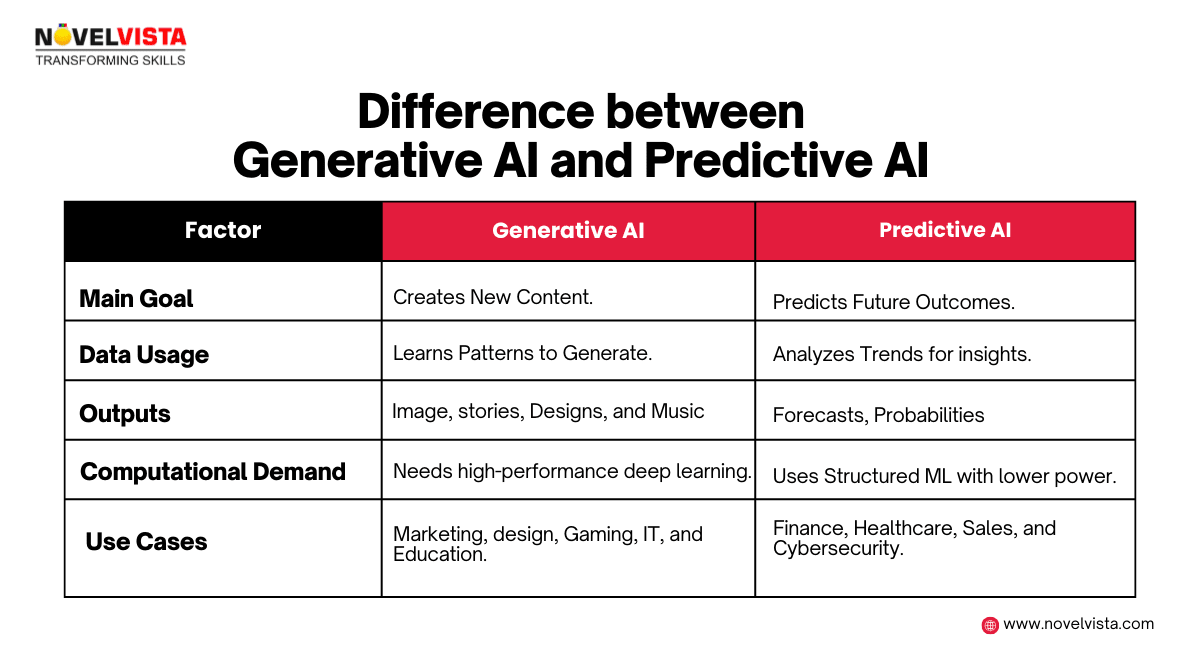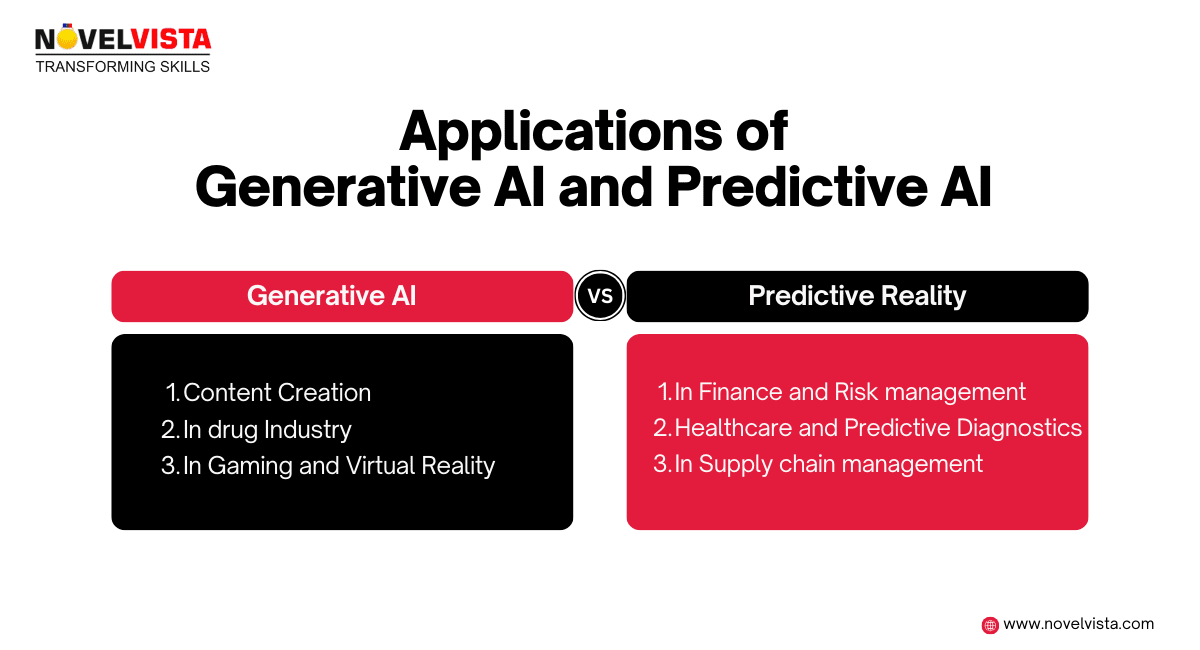Artificial Intelligence (AI) has become a transformative force in numerous industries, reshaping how we approach problem-solving and innovation. Among the various branches of AI, Generative AI, and Predictive AI stand out as two key paradigms with distinct functionalities and applications. But, what is the difference between generative AI and predictive AI, and how do they serve distinct purposes in AI applications?
Despite both being rooted in advanced machine learning, they serve different purposes and are suited for different tasks. Understanding their differences is essential for making informed decisions about their use in various domains.
So, let’s explore different factors among the Generative AI and Predictive AI along with its uses. We will also examine their special powers and practical uses, which range from enhancing financial services to transforming entertainment.
While both Generative AI and Predictive AI rely on machine learning vs deep learning models, they serve very different purposes.
|
Factor |
Generative AI |
Predictive AI |
|
Main Goal |
Creates new content. |
Predicts future outcomes. |
|
Data Usage |
Learns patterns to generate. |
Analyzes trends for insights. |
|
Outputs |
Images, stories, designs, music. |
Forecasts, Probabilities. |
|
Computational Demand |
Needs high-performance deep learning. |
Uses structured ML with lower power. |
|
Use Cases |
Marketing, design, gaming, IT, and education. |
Finance, healthcare, sales, cybersecurity. |
Both types of AI play important roles in decision-making and automation, but selecting the right one depends on your needs.
Generative AI is focused on producing new content. Be it text, images, music, or even video, the core definition of generative AI centers on producing something new. This type of AI learns from patterns in existing data and uses the knowledge to generate something new, often creative outputs. For instance, Generative AI models like GPT (text generation) or GANs (Generative Adversarial Networks, for image creation) can generate unique content based on learned structures.
On the other hand, Predictive AI makes predictions based on historical data. Predictive AI predicts future outcomes based on past trends, behaviors, and patterns. For example, Predictive AI is extensively used for sales forecasting, demand prediction, and even in the management of risk factors, all requiring accurate forecasting for decision-making.
There is a wide difference in the output between the two types of AI. The Generative AI generates original content that follows the structure and style of the training data but includes novelty. For example, it might create an original piece of music or an image or design an all-new product unknown.
On the other hand, Predictive AI gives insights, forecasts, or predictions. These outputs help users understand likely future events or behaviors, such as forecasting market trends, predicting health outcomes, or identifying potential risks in operations.
The learning process of these two kinds of AI is very different. Generative AI needs vast amounts of diverse, high-quality data to learn patterns and generate creative output. For example, to generate an image of a cat, a generative model would require thousands of cat images to learn the typical features and shapes of a cat, thereby allowing it to generate an entirely new image of a cat that was never in existence.
On the contrary, Predictive AI uses past events to predict future ones. Predominantly, it makes use of structured data such as sales records, user behavior, financial data, etc., to look out for patterns and trends. Predictive AI learns what patterns exist in the data to predict further occurrences of customer behavior or fluctuations in the stock market.
Understanding machine learning vs deep learning is essential to grasping the technology behind Generative AI vs Predictive AI.
Deep learning boosts tools like Generative AI in ITSM, where AI improves IT service management by automating ticket results and improving workflows.
Many wonder what is the difference between generative AI and predictive AI in terms of functionality and use cases. The applications of Generative and Predictive AI are as varied as the fields they serve.

Everyone's talking about Generative AI across industries, unlocking new levels of creativity and effectiveness.
Tools like ChatGpt and Jasper AI, which are powered by AI can write blogs, generate product descriptions, and it can also automate social media content.
Learn more about Generative AI in content creation and how it’s transforming businesses in our structured Generative AI Certification Course.
Explore the power of Generative AI in Drug Discovery and how it's redefining the future of medicine.
Generative AI applications are endless, but how does Predictive AI differ?

Predictive AI depends on pattern recognition and historical data to predict future outcomes.
While Generative AI creates, Predictive AI predicts—and both boost innovation in unique ways.
In addition, the same varies in terms of complexity and resource requirements. Generative AI is more resource-intensive. The building and training of generative models can be very complex, requiring sophisticated algorithms and powerful computational resources, particularly when deep learning techniques like GANs are used. Such models can be extremely computationally expensive to train and fine-tune.
However, Predictive AI often demands far less intensive computational power, especially during the preliminary development of a model. Although it is also dependent on machine learning and data processing, the latter's algorithms, such as regression or time series forecasting, are usually less sophisticated compared to generative models.
Generative AI is particularly better at creative tasks but tends to produce weaker outputs that are sometimes not specific or relevant enough if training data isn't diverse enough or the model is not well-tuned. Moreover, Generative AI is prone to creativity that might not always be practical, and there is a semblance of alignment with real-world constraints.
Now, Predictive AI is super valuable for decision-making and planning, but not so creative. Since it works with historical data, it might easily miss novel scenarios or outliers that have never been seen before. It also depends more heavily on the quality and completeness of historical data.
The decision to employ AI must be well thought out. Making a decision about the area of AI to pursue is essential to carrying out your procedure. As you may already be aware, AI learns through trial and error to improve its accuracy over time. You should decide how you want to use AI and make sure that everyone will use it in an ethical manner if you are thinking about employing it.
Think about your ultimate objective while deciding between generative and predictive AI. When it comes to developing text, finding patterns in data, or producing new material like content or images, generative AI is excellent. However, if you want to examine trends and utilize that data to create forecasts and predictions, predictive AI is perfect.
As AI evolves, so do its fair challenges.
– AI-generated misinformation, deepfakes, and plagiarism.
– Discrimination in AI-generated content because of imperfect training data.
– AI-driven decisions in hiring or lending could support existing biases.
– Over-dependence on historical data may slow down innovation.
AI governance must make sure that Generative AI and predictive AI are used responsibly and securely.
Discover how Generative AI in L&D is driving ethical and personalized learning experiences.
DON’T GET LEFT BEHIND.
Understanding what is the difference between generative AI and predictive AI helps in choosing the right approach for specific tasks. Although they both are parts of AI, they differ in what they do,Generative AIis creativity and innovation, which produces new content based on patterns learned, whereas Predictive AI focuses more on forecasting and prediction to enable data-driven decision-making by businesses.
Understanding the individual strengths and applications of each would allow businesses to begin choosing the right tool for their specific needs, thus leading to more effective and efficient AI implementations.
Confused about our certifications?
Let Our Advisor Guide You